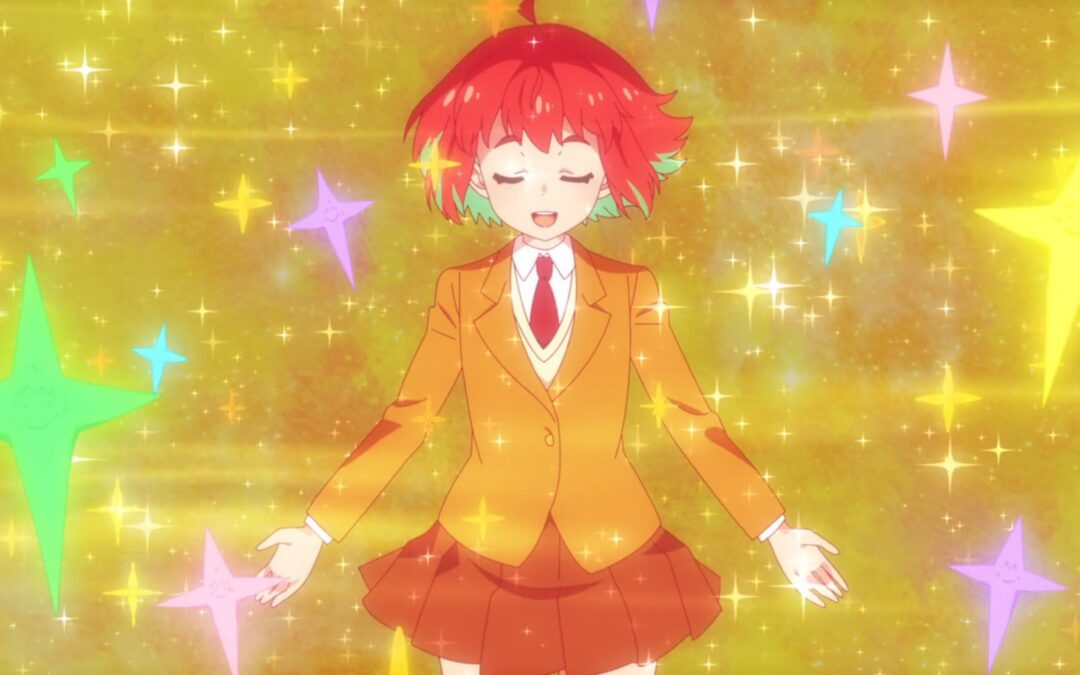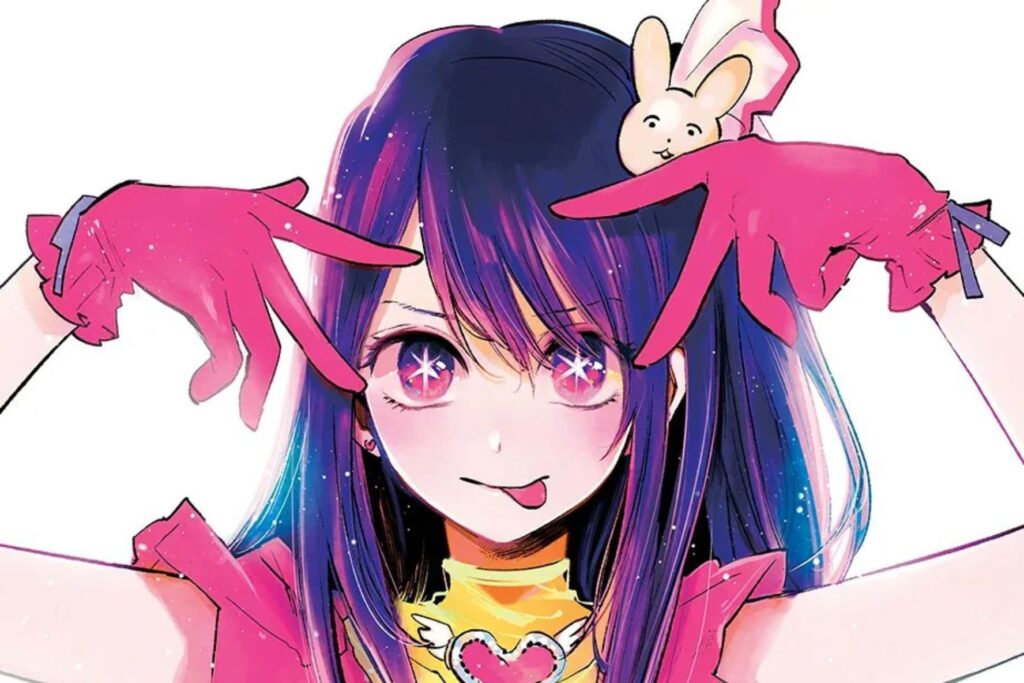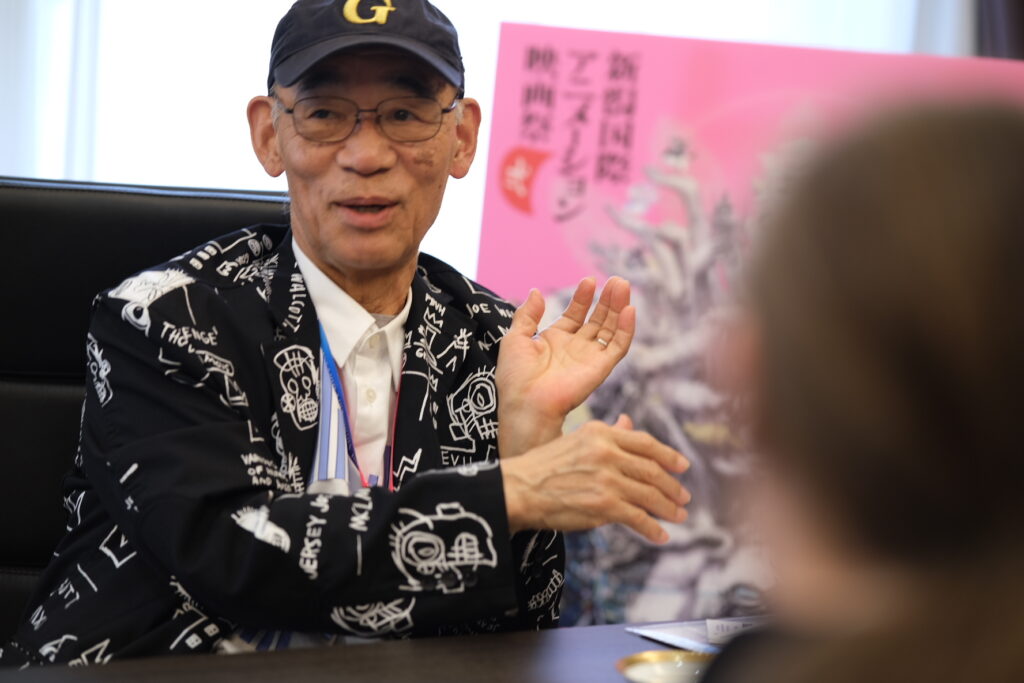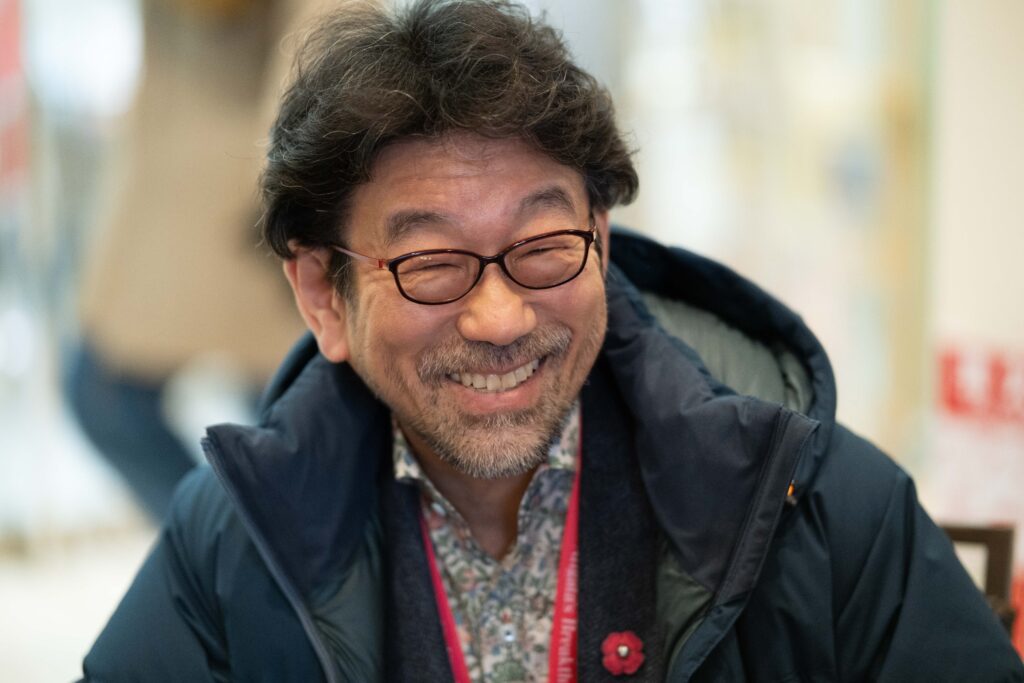With the release of the original anime series Healer Girl, we reached out to the director of the series, Mr. Yasuhiro Irie, to talk about his new show. It was also an excellent opportunity to talk about the advancement of his independently made Halloween Pajama anime project and, as the representative director of the Japanese Animation Creators Association (JAniCA), ask him to comment on the Japanese government’s declaration about wanting to improve conditions for people working in the anime industry.
We are happy to bring you this interview, but we can only do so with your help!
Help us finance future interviews by supporting us!
Mr. Irie is a well-established figure in the anime industry, which, in my opinion, doesn’t get talked about nearly as much as he deserves.
After graduating high school, he moved to Tokyo at 18 and applied for a job as an animator at Nakamura Production. There he mainly worked on works subcontracted by Studio Sunrise, such as Future GPX Cyber Formula or The Brave Fighter of the Sun Fighbird. His career took a turn when he worked on Mobile Fighter G Gundam. After working on the Sunrise Studio 2 show as a subcontractor, he permanently joined it and made his animation director debut on The Vision of Escaflowne. At Sunrise Studio 2, he would also make significant contributions to Cowboy Bebop, especially in episode 20, Pierrot le Fou, for which he designed the amusement park and delivered about 60 sheets of imageboards and layouts.
When Sunrise Studio 2 staff, among which producer Masahiko Minami, went on to create Studio Bones, Mr. Irie, who had built a strong relationship with them, would go on to collaborate with them on multiple occasions, most notably when he submitted the idea for KURAU Phantom Memories to Masahiko Minami.
Another important feat that Yasuhiro Irie got a lot of attention for was when he directed and animated the first opening of Soul Eater all by himself, featuring an array of techniques such as complex camera work and 3DCG on which he had shifted a lot of his attention since 2006.
Still, his animation work was impressive and proved that he still had an interest in hand-drawn animation, which led to him getting an offer to direct one of the most popular anime of all time: Fullmetal Alchemist: Brotherhood.
In 2013 Mr. Irie also started self-publishing his manga Halloween Pajama which he has been willing to turn into an anime. He, unfortunately, failed to raise the required funds during a crowdfunding campaign in 2017 but has not given up and has kept working on it on his own.
“I wanted to find a new way to use music”
I’d like to start by talking about Healer Girl, which has just started airing.
Healer Girl is an original anime within a Media Mix project centered around the Girls Chorus Unit Healer Girls [1]. Can you tell us how the project originated?
Yasuhiro Irie: From the start, I wanted to make an anime musical, but at the time, I had no idea about the content of what I wanted to make. When I talked about it with the producer, he told me such kinds of anime musicals don’t exist in Japan. Nonetheless, even if there aren’t musicals turned into anime, there is much anime with idols, music bands, or even anime like Macross [2], where the songs are part of the story. There was something to be made if we were to start by taking the singing aspect and using it within a frame we already have experience with, rather than taking the musical route. When thinking about how we should use the songs, we thought about Macross and Symphogear [3], where the songs are used in the middle of fights. But I was worried the battles and the songs would not blend nicely and end up too similar to those other shows. Another way to use the songs is to center them around an idol group, such as they do in Love Live! or IDOLM@STER, but that was a concept I wanted to stay away from. Love Live! [4] and IDOLM@STER [5] are very popular, but if I were to go that route, it would just be the same thing for fans and me, and Love Live! or IM@S are already much more successful. Hence why I didn’t want to do the same thing. While I was thinking about how to make a musical anime outside of these two tropes, I was thinking about a way young women could use their songs and showcase them without having to fight. It was the option that stood out the most from what had been done before. I noticed that nobody had used the idea of using songs to help people feel better.
The starting point was to make an anime where songs would be used differently, which had not been seen before, and spectators would be excited by this new approach and enjoy watching a refreshing anime series. We approached the group Healer Girls to use their songs with this concept in mind, and the chorus unit was formed alongside the anime project.
I see. So the idea for the anime came first. Among the ideas you considered, you talked about Macross and Symphogear, which are Science Fiction animes. I was surprised to see Mr. Irie say on Twitter that there were inspirations from G Gundam [6] in the 1st episode too! You were saying that at first, the girls’ master was inspired by Touhou Fuhai Master Asia.
Yasuhiro Irie: I did talk about it on Twitter indeed. In the end, you can feel the inspiration only through some visual effects in one scene.
Yes, in the climax of the episode, when everything turns golden.
Yasuhiro Irie: Exactly. G Gundam is a work that I hold very dear and which I hold very fond memories of working on. So the idea for that scene has its source in the sequence where Domon Kasshu learns the Ishibane Tenmaken and becomes gold.
I hope we will have other opportunities in the show to see homages to works dear to Mr. Irie.
Regarding how songs are used in the show, they are used as a kind of magic that heals people; it reminded me somewhat of musicotherapy. Is it intentional? Did Mr. Irie do some research about musicotherapy for the show, perhaps?
Yasuhiro Irie: I am aware of the existence of musicotherapy, but it is not something I wanted to use as a theme in the show, nor acknowledge the fact that it exists. As I explained, the starting point was how shows like Macross or Symphogear use songs during fights, and I wanted to find a new way to use music, which ended up being healing. The idea was not to use Healing as a form of musicotherapy but as a way to appease people. The way they use their powers, their singing, it’s purely fiction.
So it is really in opposition to songs being used in fights that Mr. Irie chose this approach.
In 2019, Mr. Irie joined Studio 3Hz and was in charge of training new hires. Has this activity had any influence on Healer Girl?
Yasuhiro Irie: I was in charge of training new hires for about six months. After that, I started directing Healer Girl and became too busy. The training continues but with someone else in charge. Obviously, some of the animators I trained are currently working on Healer Girl. They joined the project because they wanted to and had the required skill.
Going back to the inspirations, we talked about how Macross or Symphogear were used as a starting point to come up with your vision, but we can also find clear inspirations to idol animes in the show. The ending, for example, is a homage to Aikatsu! [7] isn’t it?
Yasuhiro Irie: Miyahara Takuya was in charge of the ending all by himself, and he is a big fan of Aikatsu! He said himself that he took Aiktasu! as a model to create this ending.
It’s interesting that even if there is an intention of creating something completely new, the whole team is clearly keeping in mind what was done before. It’s somewhat of an evolution of the genre in that sense.
Yasuhiro Irie: Indeed. Everybody is trying to take some of the stuff they like and include it in Healer Girl. It is very interesting to see what it adds to the work, and it is amusing to see this kind of “marriage” between influences.
“My priority with Halloween Pajama is to be able to keep working on it freely”
The last time I interviewed Mr. Irie, you talked about how you wanted to adapt your manga Halloween Pajama into a musical anime. Is it something you still have in mind? Or, because you were able to work on a musical anime with Healer Girl, do you want to take a different approach with Halloween Pajama?
Yasuhiro Irie: That’s right. In 2017, during the crowdfunding campaign, the intention was to make it into an anime musical. Currently, I am working on a short 5-minute anime of Halloween Pajama, about which I upload updates on my YouTube channel. This 5-minute anime will also be a musical, and I am ensuring that even the dialogues are sung. If I ever get the opportunity to make a longer anime, I want to keep in mind the musical aspect. I wish I could make it into a musical anime that resembles Wicked [8] or Matilda the Musical [9], two musicals I love.
I regularly follow Mr. Irie’s updates on YouTube. Having access to Mr. Irie’s working process on storyboards or layouts is an invaluable resource. At the time of this interview, Mr. Irie has completed the layout of 53 out of the short film’s 76 cuts. Up to what step does Mr. Irie intend to work alone? What is Mr. Irie planning with Halloween Pajama once they are done with this short film? Does Mr. Irie intend to use this pilot to convince producers to make a show? Or do you maybe plan to try a new crowdfunding campaign to make a longer episode?
Yasuhiro Irie: My goal with this 5-minute anime is to finish it and upload it to YouTube by October 31st.
So for Halloween!
Yasuhiro Irie: Exactly! And I will be doing everything by myself: the animation, the backgrounds, the compositing, the editing. I haven’t decided what I will do once done yet. My priority with Halloween Pajama is to be able to keep working on it freely. If I meet with a producer who agrees to let me do it my way, we can work something out. If I need to raise money through crowdfunding to have more means and make something longer of the best quality possible, I’ll do it. But I will not be relying solely on crowdfunding to make this anime. That’s the way I want to keep working on this anime.
Personally, I absolutely want to see a Halloween Pajama anime series. Mr. Irie’s manga is already very entertaining, but I think it has even more potential as an animated series because of its themes and visuals.
Yasuhiro Irie: Thank you very much. Your words are heartwarming and will give me the courage to keep going.
The scene Mr. Irie published today, cut 53, is noteworthy since it’s the transformation scene where Ran turns into Halloween Pajama. The way she breaks the pumpkin falling on her head to transform it’s so impactful.
[Mr. Irie puts a pumpkin mask over his head]
This one looks just like Mafty’s in Gundam Hathaway’s Flash! There is definitely Gundam everywhere when it comes to Mr. Irie! [laughs]
Yasuhiro Irie: You’re right. That’s very amusing indeed.
“If they want to produce more beautiful, more qualitative works, they have to dig deeper into their pockets”
Is it alright to discuss the activities of JAniCA with Mr. Irie?
Yasuhiro Irie: Yes, of course.
Most overseas anime fans don’t necessarily know what JAniCA is, so it may be wise to start by introducing what JAniCA is and its activities.
Yasuhiro Irie: JAniCA is an organization composed of people working in the animation industry, which was created with the goal of getting fair treatment for animators so that they can keep doing the best works in the best conditions. Our goal is to assert their rights through sensibilization and lobbying.
There are three main pillars to this organization. The first one is the working conditions which we want to improve. The second one concerns medical insurance, trying to get better medical insurance coverage, and social security. The third one regards training to ensure that everyone can get proper training and access to courses or training programs. These are the three main activities of JAniCA. Also, I said animators earlier, but it’s not only about animators. There are also coloring artists, background artists, etc. We represent every position in the industry, and they are all welcome to join the organization. Currently, there are over 2000 members.
Staff’s working conditions are a matter that preoccupies many fans overseas. They want to make sure the anime shows they watch get made in ethical working conditions. With Prime Minister Kishida’s recent declarations [10], I think it’s even more critical to give a voice and a platform to people and organizations committed to the cause and try to better working condition’s for people working in the anime industry, such as JAniCA. Regarding recent developments and the first sessions on the subject at the Ministry of Economy, Trade, and Industry, has JAniCA been approached by the Japanese government to help and consult the matters at hand?
Yasuhiro Irie: We have been in touch with government members since the creation of JAniCA. After a lot of communication, more and more Members of Parliament finally understand the harsh conditions people working in the anime industry face. Today, more and more people, in the Japanese government or from overseas, are finally aware of the harsh working conditions and how significant the anime industry is as an economy, both locally and as an export. Thanks to this, the government’s attitude changes slowly, and conditions are changing. The government understands that the anime industry is noteworthy and needs change. Simultaneously, within the industry, the decision-makers, producers, and sponsors have understood that if they want to produce more beautiful, more qualitative works, they have to dig deeper into their pockets. This is because movies such as Demon Slayer [11] or Your Name [12], which were huge successes, had great animators, reasonable schedules, and good budgets, which allowed them to have such results. The producers and sponsors finally understand that it is possible to make high-quality anime with a sufficient budget.
These movies are worldwide successes.
Yasuhiro Irie: Indeed. This is why the economic players realize this kind of high-quality anime might be more profitable. They are aware now that if they want successful shows, they will need to invest more money. Making successful anime with the budgets that have been allotted for now will become more and more difficult. Investors are starting to understand that success is tied to the consequent budgets, and I am convinced the situation will change little by little. There will inevitably be some places that will keep working on low resources hoping to make a successful work, but other places have opened their eyes and are working with more means. Those who keep thinking backward will eventually see the results and will follow. For example, lately, Bandai announced the number of productions and their budget for the following years. The number of shows stays the same, but the allotted budget increases each year. They are starting to give more means and resources while not increasing the number of titles. They begin to understand finally. Fans overseas worry a lot about these topics, but I think we finally see some change. It’s still only the beginning, though.
“It’s necessary to show how crucial in-between animators are to the production process”
Regarding money and especially wages, I think it weighs the hardest on the situation of in-between animators. I know Mr. Irie is quite sensitive to their condition. Today it’s a position only seen as a stepping stone to becoming a key animator. Consequently, it is often looked down on and poorly compensated. The other day, Mr. Shotaro Imai shared a series of tweets about his experience as an “In-between director” (動画監督) on Heike Monogatari and the situation of in-between animators. What does Mr. Irie think about their situation? What measures should be taken to improve the position’s image and working conditions?
Yasuhiro Irie: First of all let me say that I think promoting the position of “In-between director” is a great idea. I think many animators now understand that being an in-between animator isn’t just a way to become a key animator. Some animators indeed see the position of In-between animator as the first step to becoming a key animator. Still, others take the job seriously. They want to professionalize as In-between animators and don’t want to change positions. The problem is that those who stay In-Between animators don’t see any increase in their wages. About 90% of the in-between animation is currently outsourced overseas. Therefore, only a few in-between animators in Japan are working on productions. And since there are so few of them, it’s difficult for them to make their voices heard. But in the last two years, we were able to raise awareness about the importance of in-between animators, that they are essential to making high-quality anime. It’s necessary to show how crucial in-between animators are to the production process. It’s also important to raise awareness about methods and tools which can help increase the number of drawings an in-between animator can make per hour. I think it’s important for them to use software like CACANi [13], which is a significant technical evolution. Such software can ease the task for in-between animators. Where an in-between animator would only be able to make about two drawings in an hour, they can make ten with the help of this software. It makes some aspects of their work easier, increases the number of drawings they can make, and as such, also increases their salary since their pay depends on the number of drawings. I think it is important to show how important the position of in-between animators is and the importance of using technological advancements.
On the one hand, raising awareness about the necessity for in-between animators and how essential they are will help improve their image and salary. On the other hand, technological advances will also help raise their income. By using these two levers, revenue for in-between animators will improve.
Isn’t there a risk of their work getting devaluated because of such automated software? That the price per drawing would decrease because they can increase their output with such software. Isn’t it something to worry about?
Yasuhiro Irie: I understand your worries. In such cases, animators need to spread the word between them. If a studio pays less, the information will spread, and people must avoid working with them. People are already careful to choose where they go working according to the wages and conditions. Studios that pay well are prioritized, and those that pay poorly are avoided. Before the Internet, studios would say, “We have the same conditions as elsewhere.” But now, with the Internet, we can check it up. Information spreads much quicker.
Some animators are trying to call for creating an animators’ union [14]. Do you think unionizing can be a path worth considering to better the conditions of people working in the industry?
Yasuhiro Irie: I think it’s complicated to unionize in Japan. One of the main reasons is that nobody in the anime industry has ever tried it, so nobody has the necessary experience. Another reason, which concerns not only the anime industry, is that if a union is created, everybody will want to join and think: “Now I’m part of the union, I will have work because the union will be backing me.” The people in charge of the union will be overwhelmed. I think everyone should try to understand their own condition by themselves, and then share it with others to help each other out. I think there is more beauty to such mutual assistance. It’s close to the idea of a union from the perspective where we all stand with each other, but each is aware of their own condition. It’s the kind of organization I have in mind. It sounds a bit catholic in a way. You know how they say, “God helps those who help themselves.” It’s a bit like that, “Start by helping yourself, and others will help you.”
Even if it’s not through a union, you agree that there is a need for an organization of workers. Do you think JAniCA is filling this role or can fill in this role? What more needs to be set up? Or does Mr. Irie believe that things are already going in the right direction?
Yasuhiro Irie: I think the role JAniCA plays is to give each person the weapons to defend themselves individually. Once everyone is able to defend themselves, we can proceed to the next step, which is to allow for each voice to be heard directly by the government as an organization; as such more people will join the organization. By advancing step by step, we can ideally consider reaching high places. Like in anime and manga, where the hero has solved every problem and made it to the happy end, we have to get stronger and stronger without skipping any step. In Puella Magi Madoka Magica [15], Madoka throws the arrow of light to save all girls from their condition [Mr. Irie imitates Madoka shooting the bow], but we don’t have such superpowers in the real world, so we will reach results by fighting step by step.
That is a great comparison. I think it’s a nice image to end this interview with. Does Mr. Irie want to share one last message to all the fans watching Healer Girl?
Yasuhiro Irie: For all those who have started watching Healer Girl, I recommend watching it until the end. I promise that once you have finished the show, you will think, “I am glad I watched it until the very end!” Thank you for watching the show and for showing your appreciation!
Interview by Dimitri Seraki.
Translation by Fabrice Renault.
Special thanks to Matteo Watzky.
We wish to thank Mr. Irie for granting us some of his time and we invite our readers to support and engage with his works, especially his efforts on Halloween Pajama.
Notes
[1] Healer Girls. Healer Girls is a girls chorus unit formed in 2021, consisting of four members and signed under the Lantis label, a subsidiary of Bandai Namco Music Live Inc. The members are Karin Isobe, Akane Kumada, Marina Horiuchi, and Chihaya Yoshitake, who also voice the protagonists of the anime Healer Girl.
[2] Super Dimension Fortress Macross. Anime series, 1982-2016. One of the distinguishing features of this famous mecha franchise is to mix war stories and romance. In each entry of the franchise, one of the main characters and members of the love triangle is a pop idol whose music plays a role in the wider military situation.
[3] Symphogear. Anime series, 2012-2019. SF magical girl series in which idols or aspiring idols fight aliens using the power of music.
[4] Love Live! School Idol Project Series Mediamix Project, 2010 – ongoing. A mediamix brand that, through its various media, depicts the struggle and growth of fictitious idol groups. A joint project between KADOKAWA, Bandai Namco Music Live Inc., and Bandai Namco Filmworks, Inc. The idol groups are signed under Bandai Namco Music Live’s Lantis label.
[5] THE IDOLM@STER Mediamix Project, 2005 – ongoing. A mediamix project that started as a series of training simulation video games featuring idols produced by Bandai Namco Entertainment (Formerly Namco). The artists are signed under Sony subsidiary NIPPON COLUMBIA CO. LTD record company.
[6] Mobile Fighter G Gundam. 1994-1995, dir. Yasuhiro Imagawa. Created to celebrate the 15th anniversary of the Gundam franchise, this is the first entry to take place outside of the “Universal Century”. With a very different tone and setting, it featured major contributions from multiple future members of studio Bones, such as Yutaka Nakamura and Takahiro Komori.
[7] Aikatsu! Mediamix Project, 2012 – ongoing. A mediamix project that started as a Trading Card Arcade Game produced by Bandai Co. and an anime series produced by Bandai Namco Pictures Inc. The idol groups are signed under Bandai Namco Music Live’s Lantis Label.
[8] Wicked Musical, 2003 dir. Joe Mantello Book Winnie Holzman, Music Stephan Schwartz, Choreography Wayne Cilento. An award-winning Broadway musical based on the characters and settings of Lyman Frank Baum’s novel The Wonderful Wizzard of Oz.
[9] Matilda the Musical Musical, 2010 dir. Matthew Warchus, Book Dennis Kelly, Music Tim Minchin, Choreography Peter Darling. Award-winning British musical staged by the Royal Shakespeare Company adapting Roald Dahl’s eponymous novel.
[10] The incumbent Prime Minister of Japan, Fumio Kishida, declared being a fan of the Demon Slayer manga and wants to work on bettering the working conditions in the anime and manga industries. On February 28th, 2022, a first consultation on the topic with the Ministry of Economy, Trade, and Industry was held at the National Diet.
[11] Demon Slayer: Infinity Train. 2020, dir. Haruo Sotozaki. Theatrical sequel to the TV series Demon Slayer notable for being the highest-grossing film worldwide in 2020 and the highest-grossing Japanese film of all time.
[12] Your Name. 2016, dir. Makoto Shinkai. Extremely popular teen movie which became, at the time of its release, the third highest-grossing anime film in Japan and overseas and propelled its director Makoto Shinkai to immediate international fame.
[13] CACANi is a software used to automatically generate in-between frames developed by Singaporian company CACANi Pte Ltd.
[14] Animator and Character Designer Terumi Nishii has been calling for the formation of an animator union. In a series of two videos with Masuo Ueda, former executive producer of Sunrise Co., former president and CEO of A1 Pictures Co., and Aniplex Co., they discussed why they deem the creation of such a union important. [Part 1], [Part 2]
[15] Mahou Shoujo Madoka Magica. 2011, dir. Yukihiro Miyamoto & Akiyuki Shinbô. Magical girl series, which became famous for its original direction and dark writing. At the end, protagonist Madoka breaks out of a time loop and frees all magical girls from the cycle of exploitation and life-threatening combat they have been trapped in.
Like our content? Feel free to support us on Ko-Fi!
You might also be interested in
Oshi no Ko & (Mis)Communication – Short Interview with Aka Akasaka and Mengo Yokoyari
The Oshi no Ko manga, which recently ended its publication, was created through the association of two successful authors, Aka Akasaka, mangaka of the hit love comedy Kaguya-sama: Love Is War, and Mengo Yokoyari, creator of Scum's Wish. During their visit at the...
Ideon is the Ego’s death – Yoshiyuki Tomino Interview [Niigata International Animation Film Festival 2024]
Yoshiyuki Tomino is, without any doubt, one of the most famous and important directors in anime history. Not just one of the creators of Gundam, he is an incredibly prolific creator whose work impacted both robot anime and science-fiction in general. It was during...
“Film festivals are about meetings and discoveries” – Interview with Tarô Maki, Niigata International Animation Film Festival General Producer
As the representative director of planning company Genco, Tarô Maki has been a major figure in the Japanese animation industry for decades. This is due in no part to his role as a producer on some of anime’s greatest successes, notably in the theaters, with films...





Trackbacks/Pingbacks